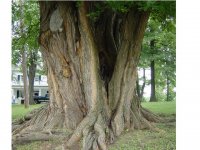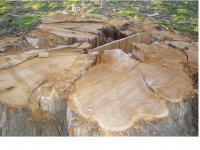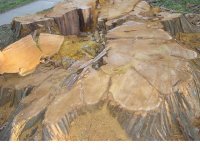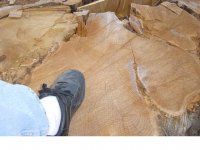You are using an out of date browser. It may not display this or other websites correctly.
You should upgrade or use an alternative browser.
You should upgrade or use an alternative browser.
Osage Orange
- Thread starter alstl
- Start date
I would have to agree with Sheldon...
Just don't like the color...
Tom
Just don't like the color...
Tom
sliprock said:How stable is Osage? Does it need coring? I saw a cue in progress with an Osage forearm during a visit to Sherm's shop. It had floating Ebony points with Ivory inlays. Very pretty cue.
Osage Orange is a pretty stable wood, like padauk... So when it's dry, you can be about sure it will never work very much anymore.
But if you want, you can core it. Better safe than sorry...
And the coring will bring the weight of the wood down a little wich in most cases is very favorable.
TIP: Osage Orange is very sensitive to light. It will darken pretty quick if you don't seal it. Because of that, try not to expose the wood for days to a light source before it has been finished...
Tom Penrose
Osage Orange, or Hedge Apple as it is commonly known in many places, is the only domestic (to the US) wood that I can think of, that cuemakers embrace with the obvious exception of hard maple. There may be others that I am overlooking, but I can't think of any. Hedge apples are also good for keeping spiders out of your house.Penrose Cues said:Osage Orange is a pretty stable wood, like padauk... So when it's dry, you can be about sure it will never work very much anymore.
But if you want, you can core it. Better safe than sorry...
And the coring will bring the weight of the wood down a little wich in most cases is very favorable.
TIP: Osage Orange is very sensitive to light. It will darken pretty quick if you don't seal it. Because of that, try not to expose the wood for days to a light source before it has been finished...
Tracy
Last edited:
Osage Orange is very prone to splitting. I have cut many inlay slabs and butt sleeves out of it but have always strayed away from using it for forearms. It has a real nice golden yellow color to it when fresh cut. I bought several logs when I lived in Missouri and had a local mill cut them into turning squares and kiln dry it for me. It had a good bit of checking. This wood gets really hard after drying. Tom is absolutely right about the color fading fast when cut. You need to use a UV resistant finish over it to prevent losing so much of the nice color. Because of the color fading and it being prone to cracking I have chosen to use Yellow Heart if I want a golden colored forearm. Osage is also a slight tone wood. This means it makes a slight ringing sound when tapped on the side.
Chris
www.cuesmith.com
www.internationalcuemakers.com
Chris
www.cuesmith.com
www.internationalcuemakers.com
For those of you interested in trees, here is the reason I was asking about the Osage Orange. A big limb broke off a tree in a park I go jogging in (see first attachment) and I talked to the audubon specialist for the county parks to find out what kind of a tree it is. I'm pretty sure this limb wound up being cut up for fire wood since the park employees burn wood in the winter for heat, but in the course of the conversation he told me that another much larger Osage Orange might have to be cut down. He didn't say when, but he indicated they would try to give it another year. This tree is not only very large, but is on a historical site, the General Daniel Bissell House. You can google General Bissell to find out who he was if you are interested, but suffice to say his commission was signed by George Washington and Thomas Jefferson and he was a contemporary of both Daniel Boone and Captain William Clark, both of whom knew him and lived in the St Louis area. Clark was a frequent visitor at the Bissell House. I don't know how old the tree is, but it's obviously old and was planted a long time ago. The house dates to 1812.
I don't know what the county's plans are for the wood if they remove the tree, but I figure a few pool cues wouldn't be a bad use for it, at least better than getting chopped up for fire wood.
For those of you who like trees and a little history, enjoy the pictures.
I don't know what the county's plans are for the wood if they remove the tree, but I figure a few pool cues wouldn't be a bad use for it, at least better than getting chopped up for fire wood.
For those of you who like trees and a little history, enjoy the pictures.
Last edited:
nice size tree,,,need to saw your blanks quickly, while it's still green,,,this osage orange/'Bois D'arc' is hard when it is dry, so forget wood working tools,,,,JMHO
Jack Flanagan said:nice size tree,,,need to saw your blanks quickly, while it's still green,,,this osage orange/'Bois D'arc' is hard when it is dry, so forget wood working tools,,,,JMHO
I'm not a cue maker, wouldn't know where to start but this is a pretty cool looking tree, thought someone might be interested. The tree is actually open in the middle, two or three people could stand inside. That's how big it is.
Good history lesson.One big ass tree.i hope it dosn't go for firewood.That would just be a waste.
bobroberts said:Good history lesson.One big ass tree.i hope it dosn't go for firewood.That would just be a waste.
If I find out they are going to cut it down I'll check here to see if anybody wants a chunk of it. If they did I would just be looking to cover shipping costs, not looking to make any money on it.
BTW, the road next to the tree was originally just a trail which led from a French village/trading post on the Missouri River to St Louis. The French village evolved into Ft Bellefontaine after Napoleon sold out to the United States. Ft Bellefontaine is where Lewis and Clark ended their journey in 1806 (the fort was built while they were gone). If you continue South on that rode toward St Louis you pass by the gravesite of Clark.
I'm not big on history but some of it is interesting.
Last edited:
update on this tree
I don't know if anyone cares, but this is an update of this old thread. I deleted the orginal pics of the tree, so I will post one pic of what the tree used to look like and some pics of what the stump looks like. Osage Orange trees are common around here, but not trees this big and this old. The house is 200 years old and my guess is the tree was about the same age. I counted well over 100 rings in one section of the stump, and the middle part of the tree is gone so there is no way to tell for sure.
I put my shoe on the stump to give an idea how big the tree is/was. My shoe is a size 13.
I don't know if anyone cares, but this is an update of this old thread. I deleted the orginal pics of the tree, so I will post one pic of what the tree used to look like and some pics of what the stump looks like. Osage Orange trees are common around here, but not trees this big and this old. The house is 200 years old and my guess is the tree was about the same age. I counted well over 100 rings in one section of the stump, and the middle part of the tree is gone so there is no way to tell for sure.
I put my shoe on the stump to give an idea how big the tree is/was. My shoe is a size 13.
Attachments
That's alot of nice lumber there....even to use for other woodworking projects....
________
________
Last edited:
Osage Orange aka Hedge
Had an Auerbach cue (Tulsa OK) with a considerable number of Osage inlays and 6 points. Had a nice light orange-yellow color. Beautiful cue.
My experience as a Missouri farmboy makes me very suspicious as to stability & workability. Makes great fence posts and burns hot hot hot! It's ultra hard when dried and prone to splitting and checking. Inlays maybe but don't think it would work well long term for forearms, handles and butt sleeves. Maybe coring would correct the potential problems but there are too many other great woods available.
Had an Auerbach cue (Tulsa OK) with a considerable number of Osage inlays and 6 points. Had a nice light orange-yellow color. Beautiful cue.
My experience as a Missouri farmboy makes me very suspicious as to stability & workability. Makes great fence posts and burns hot hot hot! It's ultra hard when dried and prone to splitting and checking. Inlays maybe but don't think it would work well long term for forearms, handles and butt sleeves. Maybe coring would correct the potential problems but there are too many other great woods available.
Last edited:
stix4sale said:here's a cue i converted,
added the bem handle and osage butt


That's a real eye catcher, good job.
That's one of the largest Osage trees I've seen. It must be as old as the house.
By the way Osage is a prefered wood of Bow makers and a favorite of the
indians for the same purpose.
I bought a Meucci in the mid 70's that is primarily Osage. Still have the cue although retired but never had any problems with the wood itself.
There's several large osage trees in Tower Grove Park.
By the way Osage is a prefered wood of Bow makers and a favorite of the
indians for the same purpose.
I bought a Meucci in the mid 70's that is primarily Osage. Still have the cue although retired but never had any problems with the wood itself.
There's several large osage trees in Tower Grove Park.



